I bought my Fujica GS645 a couple of years ago, after I decided no medium format SLR or TLR would ever be small or light enough for me to feel like carrying with me day-to-day just in case I saw something worth shooting. I’ve since used it pretty regularly with C-41 and black and white film. I’ve shot mostly portraits, but also general street photography, travel and landscape stuff.
Introduction to the Fujica GS645
The Fujica GS645 Professional (to give it its full name) is a unique camera. It’s a super compact medium format rangefinder that shoots 6×4.5cm negatives in portrait orientation with a fixed 75mm f/3.4 lens and leaf shutter.
Its name doesn’t exactly roll off the tongue, does it? I have noticed that with Fuji’s other MF rangefinders, you have the GL690 for 6×9 shots and the GM670 for 6×7 shots. So, do the L, M and S stand for large, medium and small? And the G stands for… I don’t know. Maybe it’s the “Great Small 6×4.5 camera”?
The lens and shutter are mounted on bellows. When not in use, they close down behind a lens door like one of those classic folding cameras from the 1940s and 50s.
Actually, I discovered that Fuji’s first ever camera in 1948 was their own folding 6×6 viewfinder camera, the Fujica Six. A later iteration, the Super Fujica Six even had a coupled rangefinder. So, in creating the Fujica GS645 in 1983, FujiFilm were going back to their roots in a way.
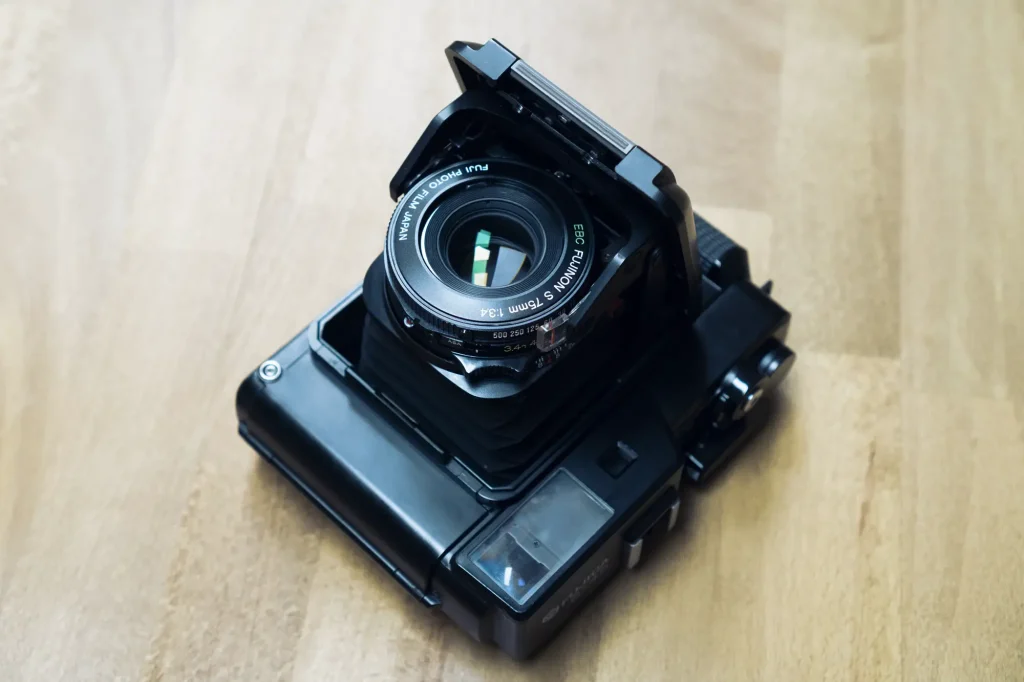
They seem to have taken inspiration from those classic folders, but improved on the design with a great coupled rangefinder, a light weight and sturdy body, a coupled film wind and shutter cocking mechanism, an inbuilt coupled light meter and a phenomenal Fujinon lens. Not to mention some seriously modern styling (by early 1980’s standards).
I don’t know for sure what Fuji’s intentions where when they gave the world the GS645, but I’ve given it quite a bit of thought, and I’m happy to speculate based on what I see as the evidence. This Fujica GS645 definitely isn’t for everyone. However, for a certain type of photographer looking for a camera to fulfil certain needs, it’s damn near perfect.
Features
In this review I’m going to describe the features of the camera in quite a bit of detail. I know how annoying it can be when you want to read a review and find yourself instead reading a padded out spec sheet. But, in this instance I think it’s actually really useful to look in detail at the features and design decisions Fuji made in creating this camera. That’s really the only way to understand what the hell it is, how it works and who it’s for.
The lens
The Fujica GS645 lens is a five element 75mm f/3.4 EBC Fujinon S. That’s about equivalent to a 45mm lens on a 35mm film or full-frame digital camera. This can be worked out by multiplying the focal length by a crop factor of 0.6. Anyway, this makes the lens “normal” on 645, much like a 50mm lens on a 35mm camera.
F/3.4 is a funny aperture, just a bit brighter than f/3.5. It’s something between a third and a half stop brighter than f/4.
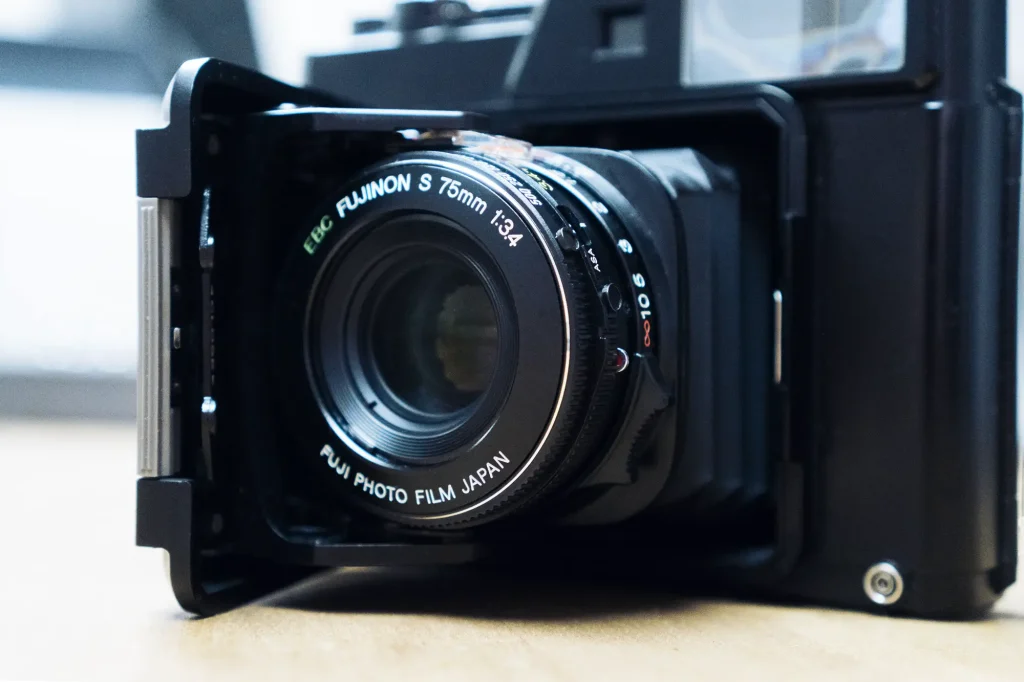
I really like the lens. To me it looks sharp at any aperture, including wide open. I don’t consider it a character lens and it isn’t particularly a lens for mega shallow depth-of-field. However, the in-focus areas are always sharp and contrasty, and the out-of-focus areas are smooth with modest and non-distracting bokeh. This can result in really nice subject isolation without the depth-of-field being that shallow.
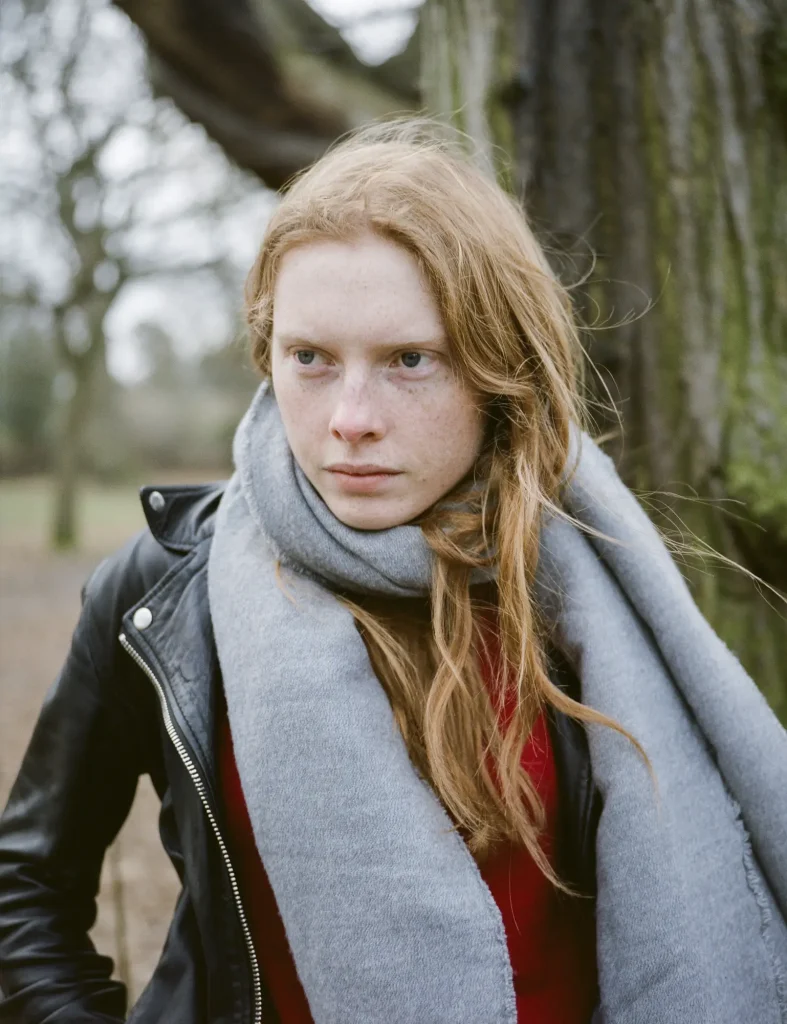
The Fujica GS645 focuses down to one meter, which isn’t very close but it’s close enough to get a half-length portrait at a comfortable working distance. Sometimes I wish it focussed 20 or 30cm closer, but the lens is sharp and the negative is big, so I’m happy to just crop in if I feel the need.
I’ve never had any real problems with lens flare. You can of course force a small flare by putting the sun in your frame. One interesting thing about the design is that the open lens door acts as a pretty decent lens shade on the right hand side of the camera. So, if you’re worried about flare for a particular shot and don’t own the accessory lens hood (more on this later), just rotate the camera so that the lens door gives the front element some shade. I’m honestly not sure it’s necessary though. Those EBC coatings are amazing.
Getting closer
There’s actually a weird close-up accessory that uses diopters and a hotshoe mounted close-up finder. I picked the set up as it came with two of the accessory filter holder lens hoods. It works like this. You attach the close-up diopter to the hood, put the hood on the lens, set the lens to either infinity, 2m or 1m. You then match that setting on the accessory finder. Focus is achieved by looking through the accessory finder and leaning in and out until you see your subject is sharp on the finder’s microprism.
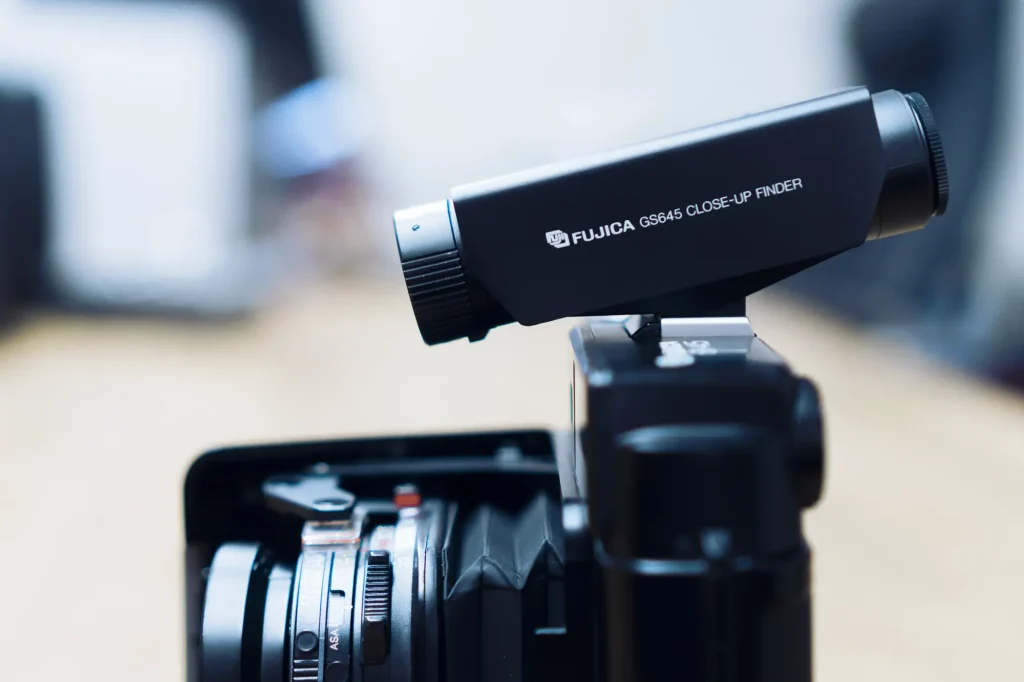
I have to confess to only having tried using it a couple of times, and I found it kind of hard to use. The image in the finder is both flipped and upside down, and depth of field in the microprism is razor thin. I mean so thin that sometimes I just can’t find the focus point at all. Imagine using a TLR handheld at macro distances whilst drunk and hanging upside down. I’m sure it’d get easier with practice. It’s a clever solution, and it corrects for the parallax error, but I do wonder why Fuji didn’t go for an accessory close-up rangefinder like the Zeiss Ikon Contameters.
Controls
Aperture, shutter speed, focus and ISO are all set on the lens barrel of the Fujica GS645. This of course means those controls are inaccessible but protected when the lens door is closed. Aperture, shutter and focus are all controlled with your thumb on the lens barrel, and are easily identified by feel despite being fairly tightly grouped together. The shutter wheel has click stops, the aperture wheel is step-less, and the focus wheel has a nice, comfy thumb rest.
Focus throw is about 90 degrees from 1m to infinity. The lens barrel is marked with a basic depth-of-field scale and an infrared focus point.
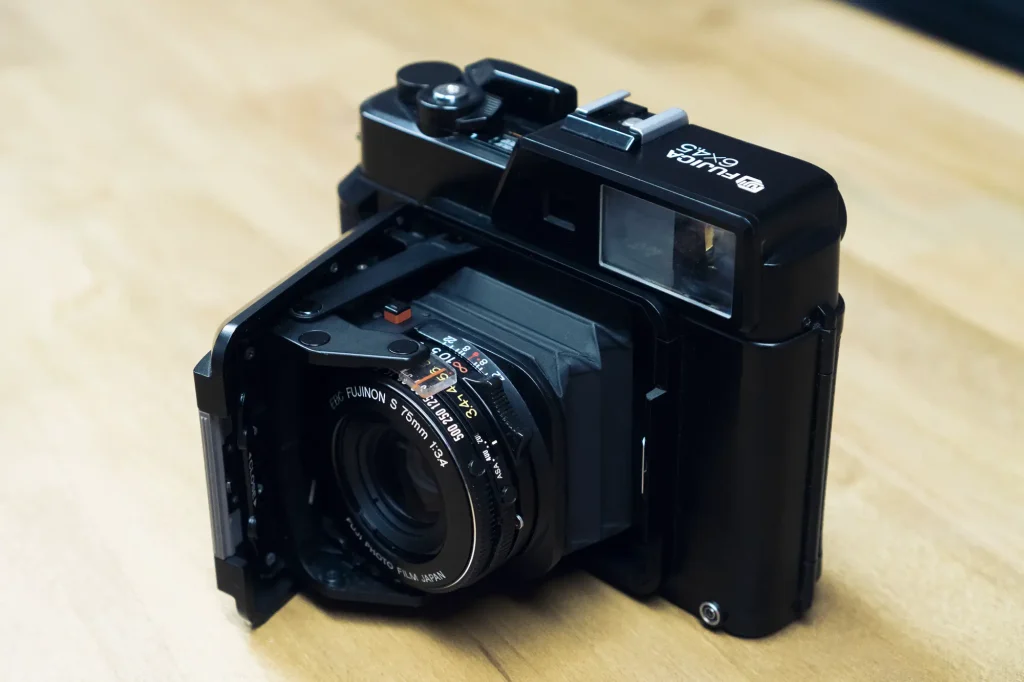
The Copal #00 shutter has speeds from 1/500 down to one second in full stops, as well as a T setting for longer exposures. If T (time) mode is unfamiliar to you, it’s similar but a little different to the more common B (bulb) mode. With T mode you press the T button (located on the lens mount) to open the shutter, then when your exposure is done you press the normal shutter release button to close the shutter. I suppose the advantage is that you don’t have to hang around holding down the shutter button for really long exposures. There is a disadvantage though which is that the T button is not threaded for a cable release.
The aperture goes from F3.4 down to F22 on a step-less aperture wheel, so you can easily dial-in half stops, third stops, or anything in between.
The shutter and aperture rings do feel a bit plasticky. The focus ring action is nicely dampened and the shutter speed stops have a solid, sturdy action to them. The aperture wheel is the one part that brings the perceived build quality down. It’s not dampened like the focus wheel, and feels a little flimsy, generally. The advantage of the slightly loose feel to the aperture is in the speed at which you can change your exposure. More on this later.
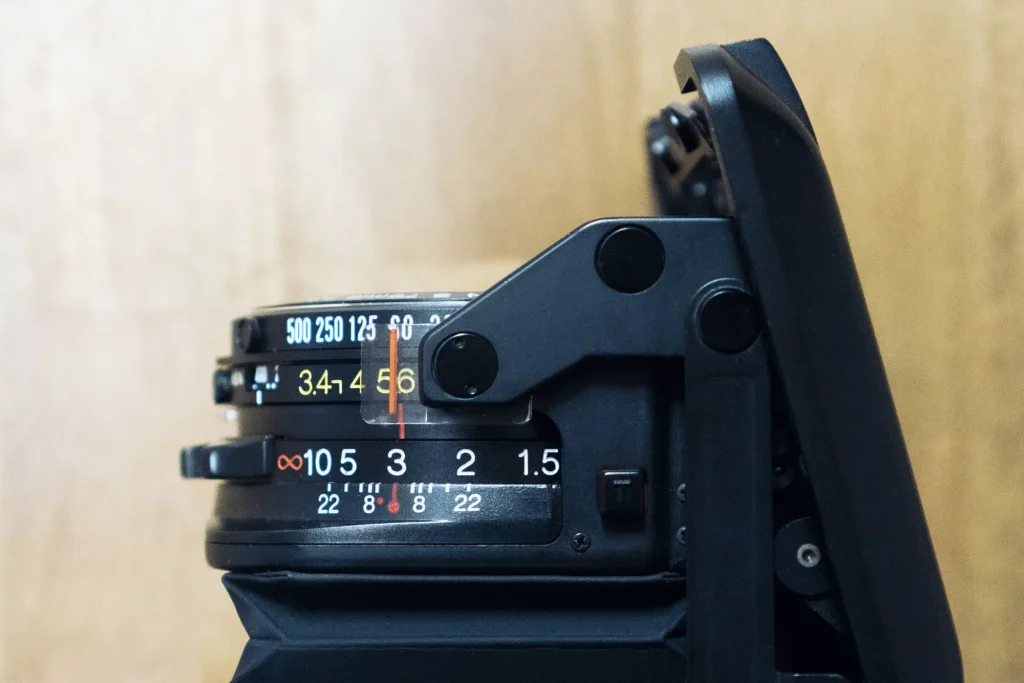
The chosen setting of shutter, aperture and focal distance all line up to the same index mark, so conveniently you only have one place to look.
Another cool feature of the design is that the shutter speed ring and aperture ring go in opposite directions. What I mean is, when you turn the shutter ring anti-clockwise you get a higher shutter speed and when you turn the aperture ring anti-clockwise you get a larger aperture. This means that you can set a correct exposure and then flatten your thumb over both wheels to turn them together, changing the shutter speed and aperture combination but maintaining your exposure.
There’s also a very discreet self-timer lever that until writing this I’d total forgotten about and never used. It’s supposed to give an 8-9 second delay. Mine runs for 7 seconds.
The viewfinder
The Fujica GS645 viewfinder shows you the meter reading using a simple – 0 + LED display in red on the right hand side. There are bright frame lines in the finder that automatically adjust for parallax error as you focus.
The rangefinder patch is decent. It’s not the kind of bright, hard-edged patch you’d find in a Leica M or Zeiss Ikon ZM but it is nevertheless very usable. The viewfinder has that slight blueish tint that many rangefinder cameras use to increase contrast with a yellow rangefinder patch and frame lines.
If you need to know, the viewfinder is 0.63% magnification, the rangefinder has a 39.5mm base length and a 24.9mm effective base length. That sounds fairly short, and since I started using a long base length 35mm rangefinder, it has started to feel short. Having said that, I’ve never had any problems hitting focus wide open at minimum focus distance, so it can’t be so bad really.
The viewfinder takes 19mm x 0.75mm threaded eyecups, diopters, magnifiers, etc. As far as I can tell Fuji never came out with any of their own accessories for the viewfinder. Many compatible 19mm threaded pieces are marketed as “Nikon eye cups”, “Nikon diopters”, etc. Armed with that knowledge, it’s quite easy to source anything you might need for the Fuji. I bought myself a rubber eye cup but pulled the rubber bit off, just leaving the metal mount. This gives just enough shade to the viewfinder for me without blocking the meter readout or frame lines.
The light meter
Exposure is fully manual with a coupled centre-weighted meter that is activated on half-press of the shutter button. Film speed for the meter can be set from 25-1600 ISO in 1/3 stop increments and measures 3.5 to 18 EV at ISO 100. The meter reads though the viewfinder rather than through the lens. This means you have to remember to dial in any exposure compensation for filters using your ISO setting. The meter is powered by two cheap and easy to source LR44 batteries.
The meter’s – 0 + display works as follows. 0 means correct exposure. A combination of 0 and a dimly lit + means you’re 1/3 stop overexposed. 0 and + fully on together means you’re between 1/3 and 1 stop over. A dim 0 and a fully bright + mean you’re 1 stop over. A lone, bright + means you’re more than 1 stop over. I won’t type that all out again with the “–” for underexposures, I’m sure you get the picture. It’s less complicated than it sounds, and I don’t find myself being too careful about it when shooting Black n white or colour negative film. I have shot slide film in this camera and always found the meter to be spot on.
Fuji mentions in the manual that the meter is designed to be particularly resistant to false readings in diagonally backlit situations. Thanks Fuji.

Though exposure is manual, but I often use the camera in a sort of pseudo shutter-priority mode. I pre-set the shutter speed. The meter readout combined with the fast action of the step-less aperture wheel then allows me to select a suitable aperture setting for a given scene in a fraction of a second, without taking my eye from the viewfinder.
The Fujica GS645 body
It’s a mix of plastics and metal. It feels sturdy and has a reassuring weight without seeming heavy. It weighs 820g if that means anything to you.
The lens door and front of the camera body are smooth plastic and have rounded edges. There’s a raised and textured front and rear grip on the right hand side that sits very comfortably between my fingers at the front and base of my thumb at the back. I love this. The ergonomics work.
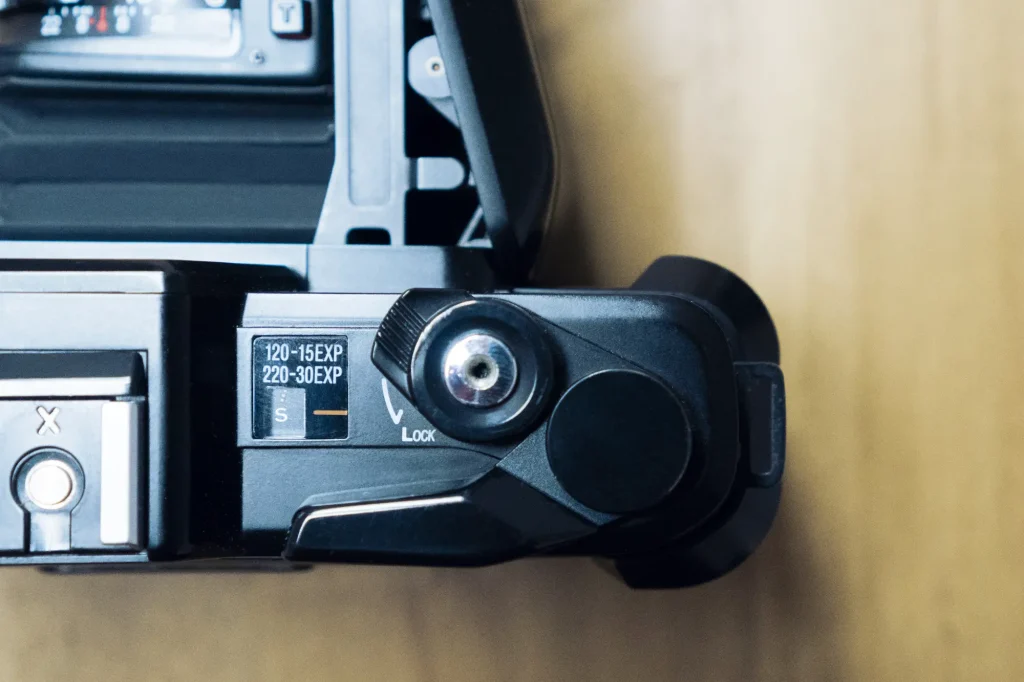
The shutter button has a standard cable release thread and is ringed by a shutter lock control. You may wonder why the shutter lock is necessary, considering the shutter locks regardless when the lens door is closed. The additional lock is actually useful in my experience because when you own the lens hood/filter holder, you will find yourself at times walking about with the lens door open for extended periods.
The single stroke film advance leaver is pretty standard. There’s a hot shoe as well as a PC sync socket. The back of the body features a switch to change the film counter mode from 120 to 220 film. There’s also a window to tell you whether you’ve got your pressure plate set for 120 or 220 film (something you can set with the film door open).
These cameras also came with a sticker reminding the user of the steps required to close the lens door. Mine’s in Japanese. Finally, you’ve got the ever useful film reminder slot.
Disorientation
The film runs through the camera horizontally from left to right, which means the frame is in vertical/portrait orientation when holding the camera normally. This is of course the opposite orientation to that of 35mm cameras and most other medium format cameras too. Whilst you can of course turn the Fujica GS645 camera 90 degrees for horizontal / landscape orientation, I find I rarely do. Naturally, it’s more comfortable to use any camera in its natural orientation, so it’s great if you shoot a lot of portraits. It also changes the way I shoot street and landscape scenes. Using it, I start to see the world in portrait orientation, and seldom think to turn the camera.
How loud is it?
I’m not really a street photographer, so it’s not hugely important to me, but you might be wondering how discreet the Fujica GS645 is when out and about. Well, it’s black and not very big so I think visually it’s fairly inconspicuous.
Focusing, being manual, is totally silent. The shutter has a surprisingly loud snap to it. Loud for a leaf shutter camera, I mean. Actually, it’s not the shutter itself but some part of the triggering mechanism smacking into itself or part of the body that makes the noise. When I tried the self-timer I noticed that the snap happened when I hit the shutter button to start the timer. The leaf shutter itself made the gentle sound you’d expect as it fired after the 7-second delay. I wonder if it’d be possible to dampen that initial snap somehow?
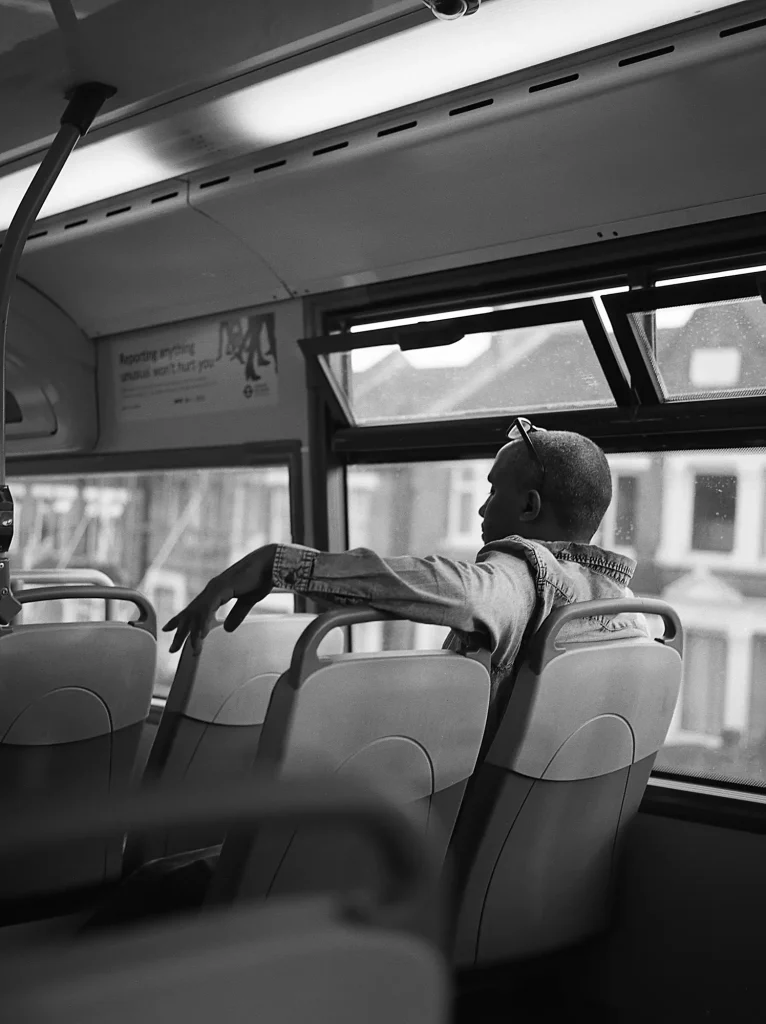
Anyway, I don’t find that the Fujica GS645’s shutter draws much attention on a busy street (or bus). The funny thing is, Fuji did have a very quiet shutter on the later GF670 (Voigtlander Bessa III), and I’ve seen several people complain that it was too quiet.
A bad reputation?
Despite all this good stuff, there’s quite a bit of of negativity online about Fujica GS645. Many seem to see it as a bit fragile and a flawed design. It does definitely have its idiosyncrasies, but in my opinion these are mostly trade-offs for features of the camera that are unique and often ingenious.
Bellows
Let’s get this one out of the way first. The original bellows were bad. It seems they were prone to wearing out relatively quickly and developing light leaks. Fortunately my first Fujica GS645 had brand new bellows when I bought it. Another unit I picked up recently had a bellows full of holes. If you want one of these cameras, ideally try to find one that’s had them replaced. Otherwise check the bellows carefully, particularly in the corners. Replacement bellows are fairly easy to find, but the process of replacing them seems surprisingly risky. Many run into problems with the shutter linkage when they get the thing opened up, so best to get a professional to do it unless you’re supremely confident.
Shut the front door
In order to close the camera the film must be advanced (i.e. the shutter must be cocked) and the lens must be focused to infinity. To close the door you then place your thumb on the wide grey button on the outside edge of the door and your index and middle fingers on a particular two points on the opposite inside edge of the door. You pinch your fingers in against your thumb and the hinge then unlocks and allows you to swing the door closed. That was way more complicated to describe than it is to actually do. In practice I find it really easy and totally intuitive. My fingers and thumb just land on the correct points, the ergonomics are lovely.
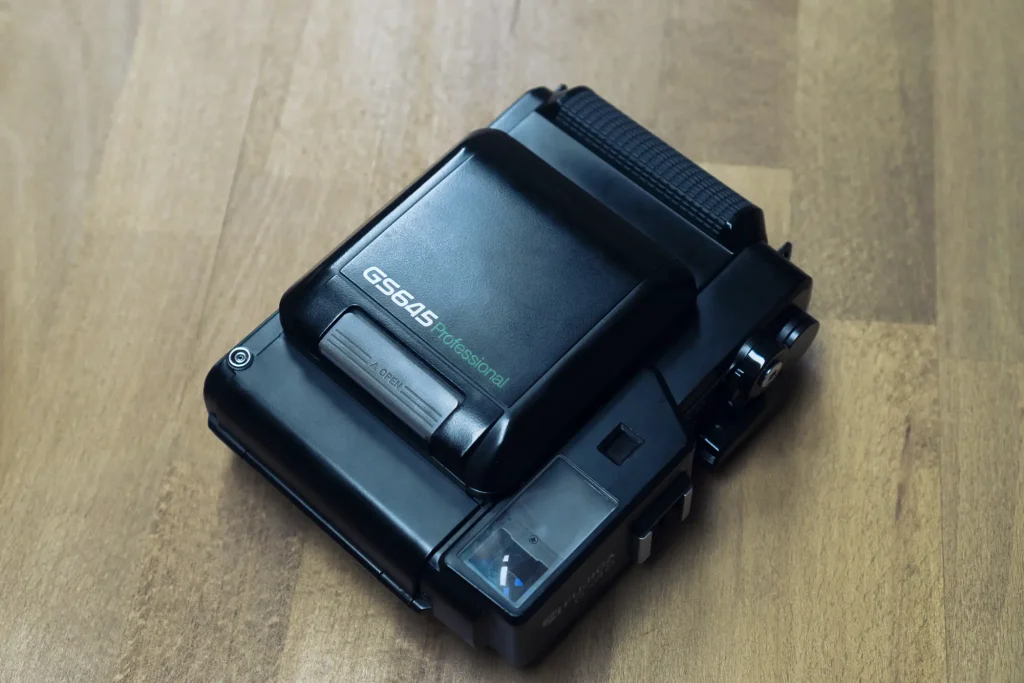
You may struggle to remember the film advance+infinity focus part your first couple of times out with the camera, but it’ll soon become second nature. If you try to close the lens door without following this procedure, it simple won’t budge. If you react to this by trying to force it closed rather than remembering the correct procedure, you could potentially break something. For some reason the internet is full of stories of people doing exactly that, which honestly baffles me.
Why is the camera this way? The film advance is coupled to the shutter cocking mechanism via some clever mechanics that are hidden neatly behind the lens door. Without this, you’d have to physically cock the shutter on the lens, separately to advancing the film on the camera body. This was always the way of things with the vintage folders, where it’s a pain because it’s an extra step and can lead to accidental double exposures or missed shots.
Apparently this mechanism in the film door totally disengages from the camera body when the door is closed, and it is only when the shutter is cocked that the mechanisms engage correctly together again. So, Fuji put in a failsafe that prevents the door from closing and damaging the shutter mechanism when the shutter isn’t cocked. I may be wrong, but that’s how I understand it, anyway.
The lens is, of course, physically at its shortest when focused at infinity. So, when focussed at infinity, the lens and bellows can be folded down to the most compact form possible. Focusing to infinity saves you 6mm of overall camera depth vs the minimum focussing distance of 1m. I suppose the designer could have allowed for closing the door with the lens set at any distance but that would have changed the dimensions of the camera quite significantly.
The filter issue
You can’t attach a filter directly to the lens of the Fujica GS645. If you could, you wouldn’t be able to close the camera with the filter attached. That tells you how close the back of the door is to the front of the lens when closed. If Fuji had left space behind the door for a filter the camera would have to be at least another 4 or 5mm deeper, overall.
Instead, filters can be attached to the accessory lens hood. The lens hood has a snap on, snap off action, which is faster than screwing a filter into a lens.
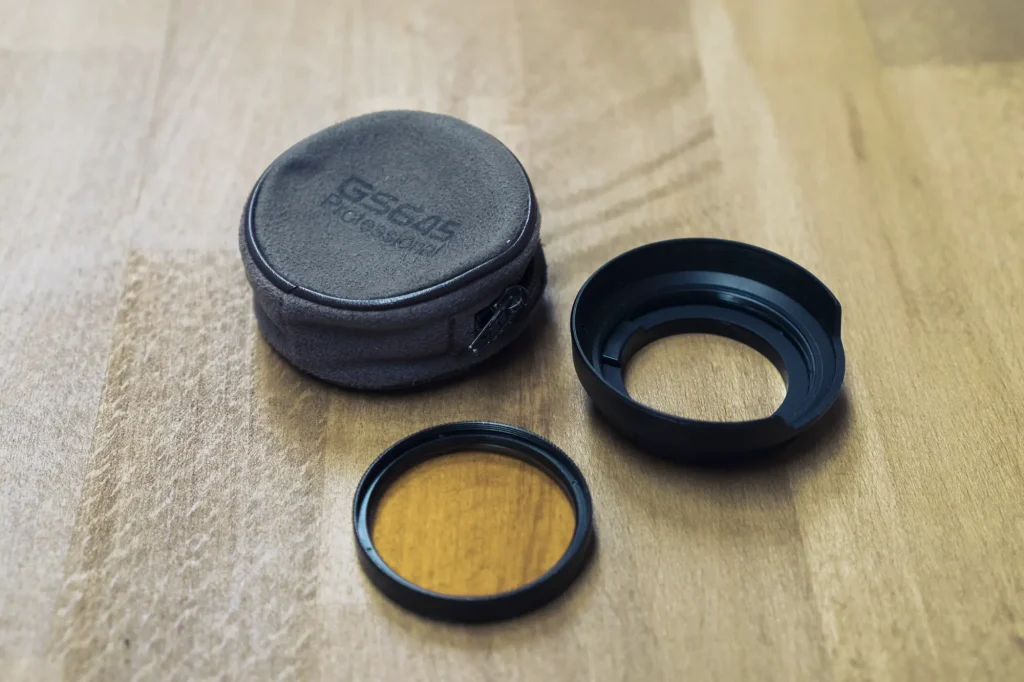
Of course, you can’t close the lens door with the hood attached either. Instead, you store it in a little pouch that threads onto your camera strap. I think this is a pretty good solution. The little pounch is made of a suede-ish fabric that polishes finger prints off your filter. Unfortunately the gaps where you thread your camera strap through the pouch can let quite a bit of dust and fluff through. The requisite filter thread size is 40.5mm, which sounds weird but is actually a common size, and generally easy and cheap to source.
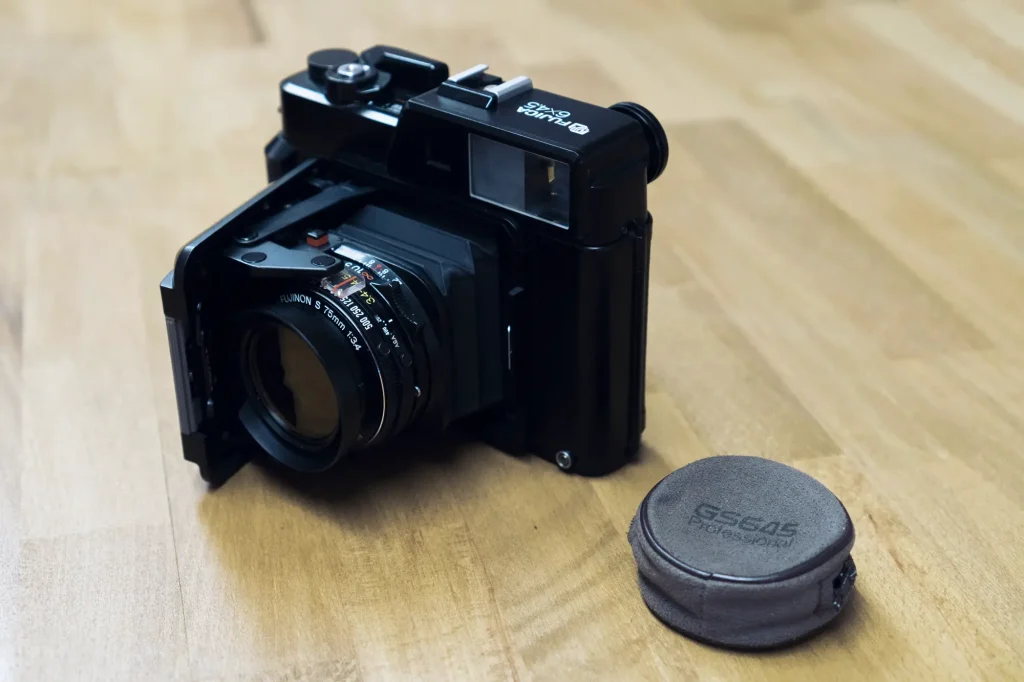
Feeling fragile
Is it fragile? Many seem to think so. In truth, it’s not a straightforward question to answer. With the lens door closed it is pretty tough. With the door open, slightly less so. Bellows are a vulnerability on any camera that has them. If you take reasonable care with the camera there’s no need to worry about it, really. I throw it in a bag along with all sorts of other stuff, with not additional case and it always comes out fine.
One thing I love about the camera is that, other than the meter, it’s totally mechanical. Fuji’s autofocus, auto-wind GA645 series will go the same way as all the electronic compact cameras eventually, whilst a well cared for Fujica GS645 could live on and on.
Design conclusions
It seems to me that FujiFilm gave themselves a very clear brief when they designed the Fujica GS645. I don’t think they were aiming to create a medium format camera that was all things to all men. Surely, their aim was to create a camera with modern usability, capable of creating work of exceptional quality, that prioritised compactness and portability over all other factors.
I think the evidence is all over the camera itself. Just look at the lens door and filter/hood arrangement, where they’ve made design decisions that shave off every possible millimetre of camera depth.
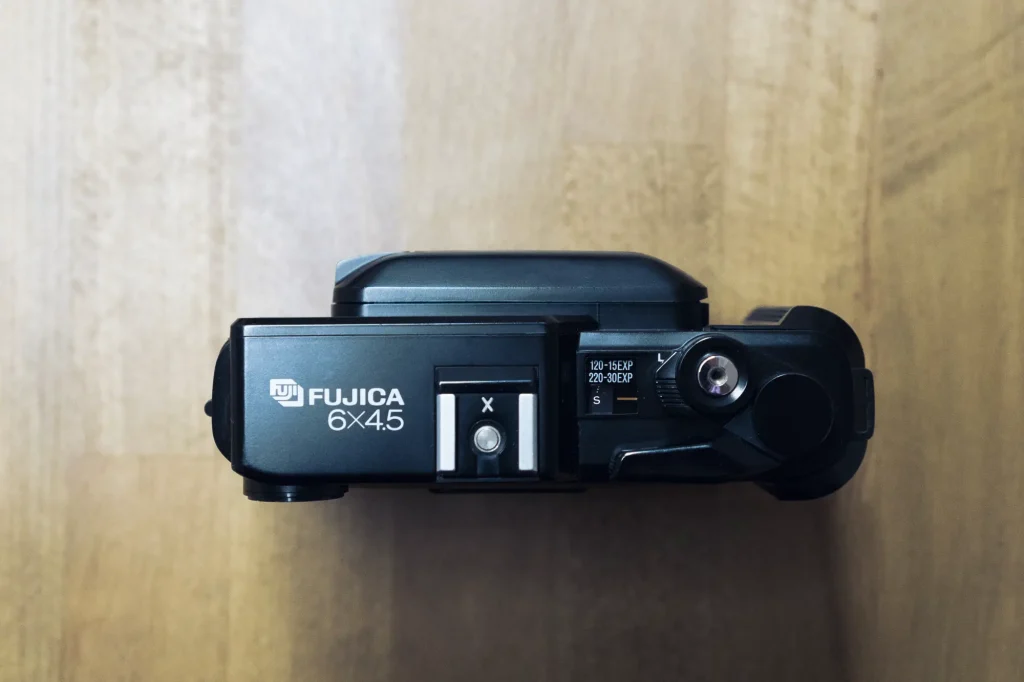
The best camera is the one you have with you (apologies for wheeling out that old chestnut), and we all know we’re more likely to be carrying the one that fits comfortably in our pockets.
Imagine if the one you could comfortably carry with you was medium format? It seems incredible, but I find the Fujica GS645 significantly more convenient to carry than a 35mm SLR or rangefinder. The lens attached to a 35mm SLR or rangefinder gives it an awkward shape. They just don’t slip into a pocket. And have you ever tried slipping a Mamiya, Pentax or Bronica 645 into your pocket?
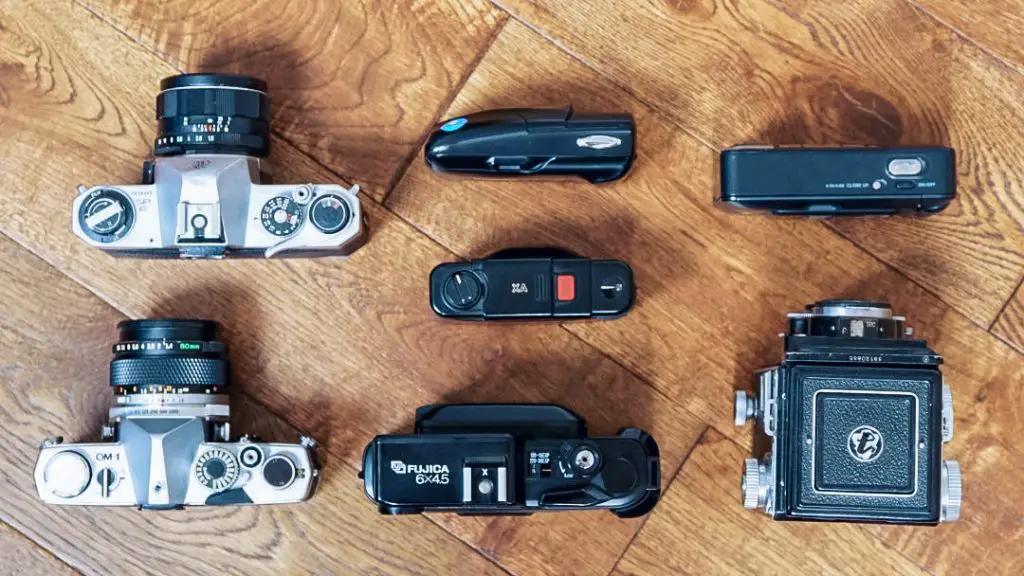
I think most of us love an Olympus Mju-II or XA not because they are objectively that great, but because they are pretty damn great and super easy to carry around with you.
Much like the great film compacts, the smooth plastic of the Fujica GS645’s lens door and rounded edges make it easy to slip into your coat pocket. The textured and raised right-hand grip makes it easy to grab and lift out again.
If you hang it on a camera strap, the right-hand side mounted strap lugs and minimal overall depth of the camera allow you to comfortably tuck the camera under your arm. I find this far more comfortable than having it bouncing annoyingly in the middle of my chest. The smooth and rounded lens door on the front prevents the camera from snagging on your sleeve or getting bashed about by your arm. The textured back and grip help to keep the camera securely in place next to your body, rather than swinging about.
The longer I own the camera, the more of these little details I notice and appreciate.
Alternatives
There really aren’t any direct alternatives to the Fujica GS645. The closest alternatives in relatively modern 6×4.5cm medium format rangefinders include its siblings the GS645s Wide60 (35mm equivalent) and GS645W (28mm equivalent and scale focus), and Bronica’s interchangeable lensed RF645. Then there’s Fuji’s later autofocus GA645 series.
But none of those combine:
- A lens as fast as the 75mm f/3.4 Fujinon
- A “normal” 45mm equivalent focal length
- A folding bellows + lens door design
- A rangefinder
- Full manual control
- Anywhere near such a compact package overall
It’s true, there were many 1940s/50s era folders with 75mm f/3.5 lenses (even one or two with f/2.8 lenses, I think), in either 6×6 or 6×4.5 format. I love the way those old folders look. In use though, I find they are generally much heavier than expected, temperamental, low contrast, soft-lensed, dim-rangefindered (usually uncoupled), with fragile, slow shutters and no light meter. For me at least, they’re not a viable alternative.
Otherwise, you could go for a bigger format camera such as the Mamiya 6 or Mamiya 7. But those are of course much larger, and heavier, with a more awkward form factor (not to mention more expensive).
In my opinion, its closest relatives in terms of design aesthetic are perhaps the 6×7 format Plaubel Makinas (both the 67 and 670). Those are also very compact (relative to their format) and feature a collapsible bellows, prioritising minimal camera depth and with smooth “pocketable” bodies. Incidentally, both the Fuji and the Plaubel 670 were popular with the photographer Helmut Newton, something I realised after watching Frames From The Edge. Whether he saw them as similar I have no idea, but we can assume both cameras met his needs for one reason or another.
Then of course you have Fuji’s much later GF670 (also known as the Voigtlander Bessa III). It may have been designed by Cosina Voigtlander, but the ancestral link back to the Fujica GS645 is pretty clear.
Final thoughts
In case it wasn’t already massively obvious, let me state it plainly: I am a big fan of the Fujica GS645. It’s such a great camera to carry with you, and you don’t compromise quality for that convenience, either.
I bought it knowing I would love the portability. I’d always imagined it to be mostly a street / travelling / days out type camera. I wasn’t massively confident with rangefinder focusing at the time, either. I certainly never imagined the shots I would take with it would rival what I could do with an SLR. I’m a portrait guy and I love to use my Pentax 6×7 or Olympus OM cameras for that stuff. But I really think some of the best portrait shots I’ve ever taken were taken with my Fujica GS645.
My Website
My Twitter
My Instagram
Share this post:
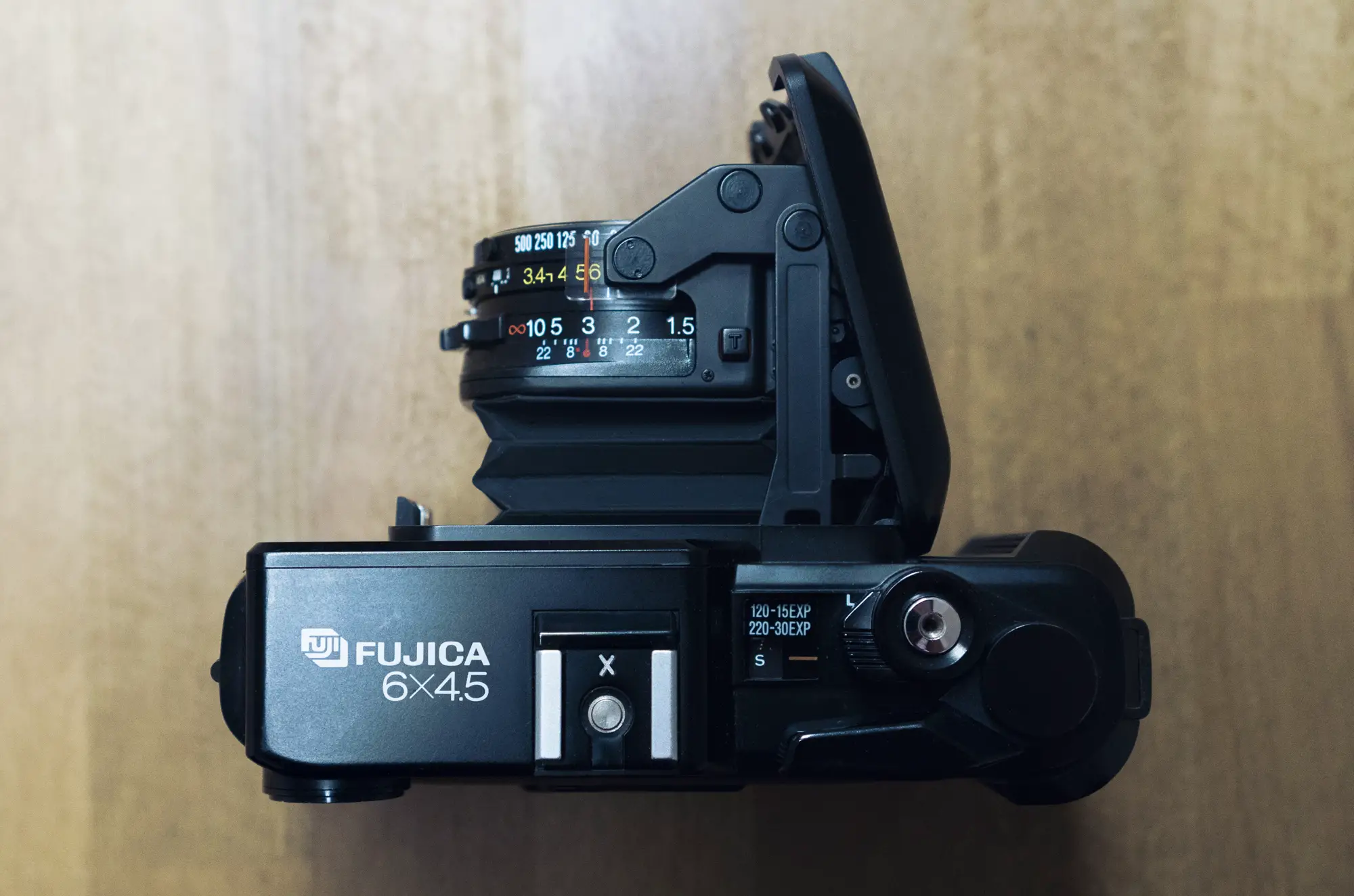
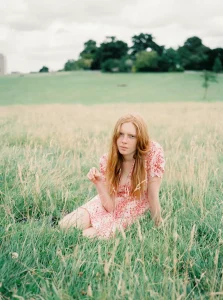
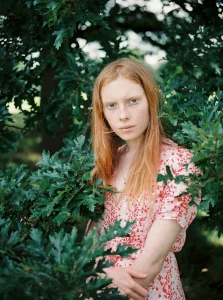
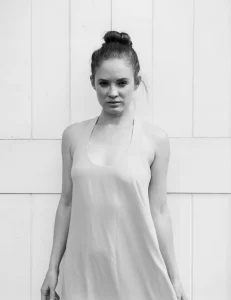

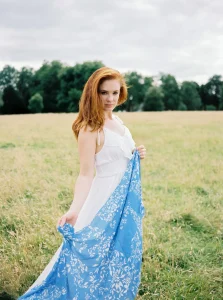
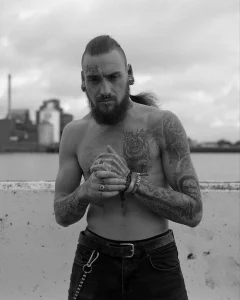

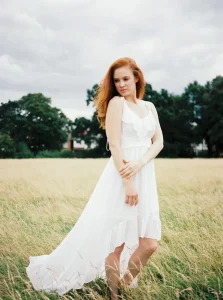


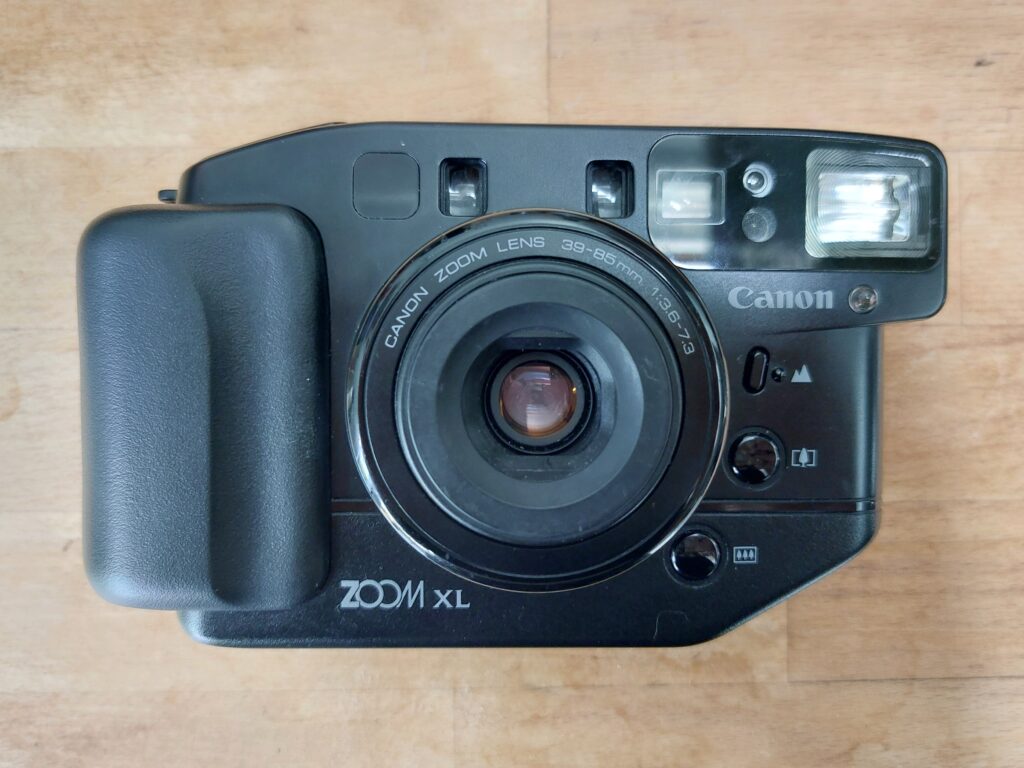
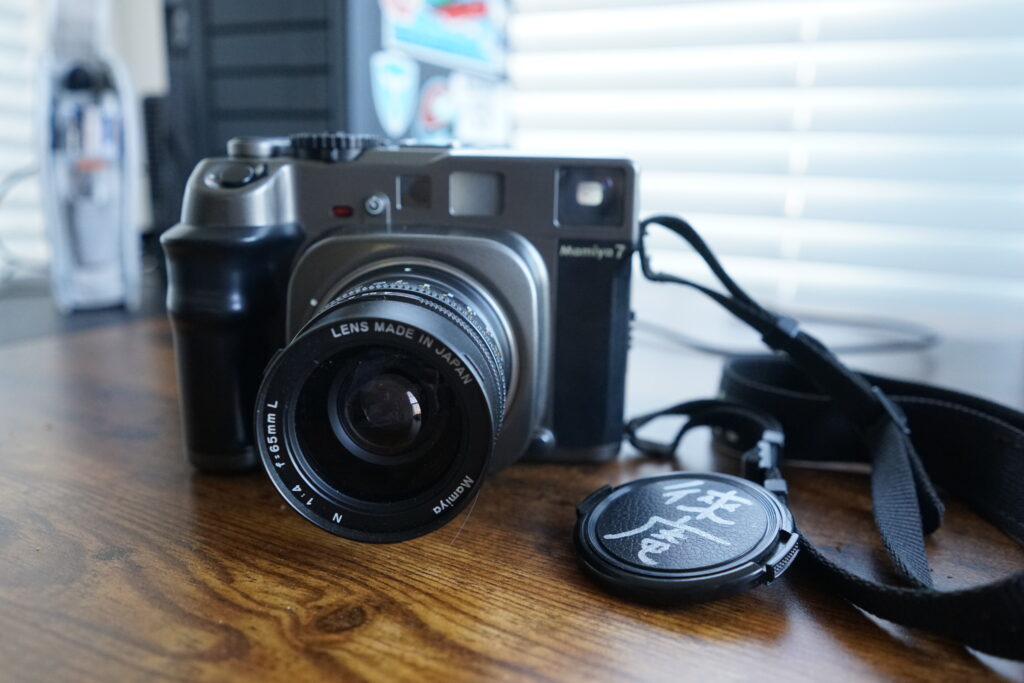
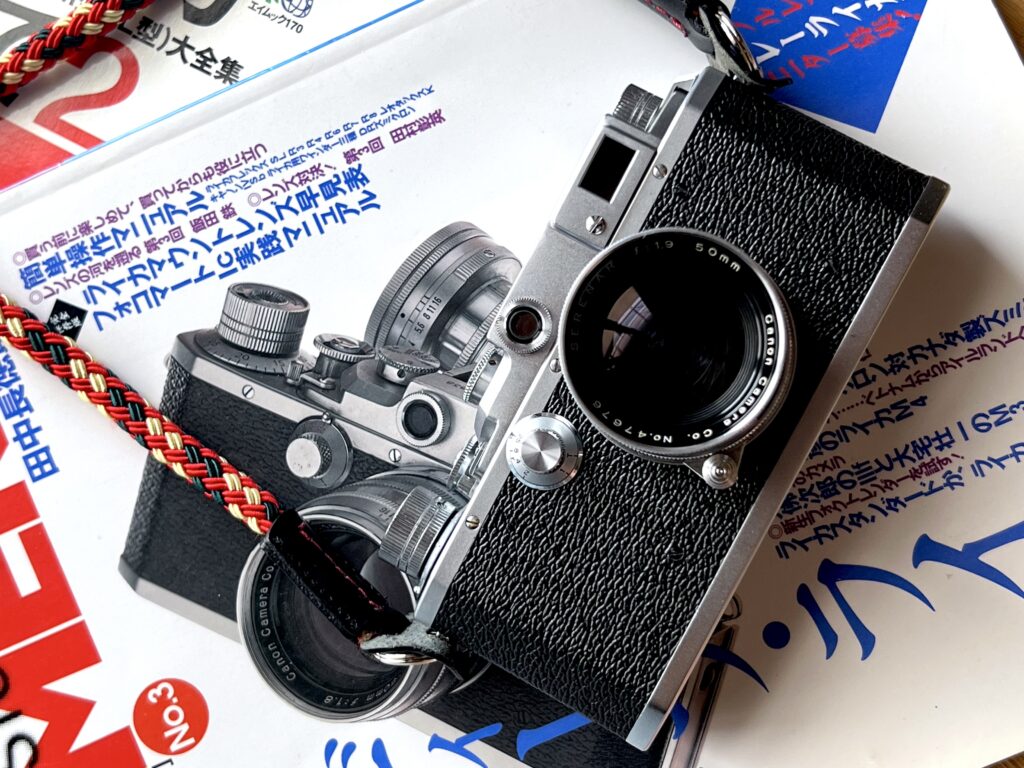
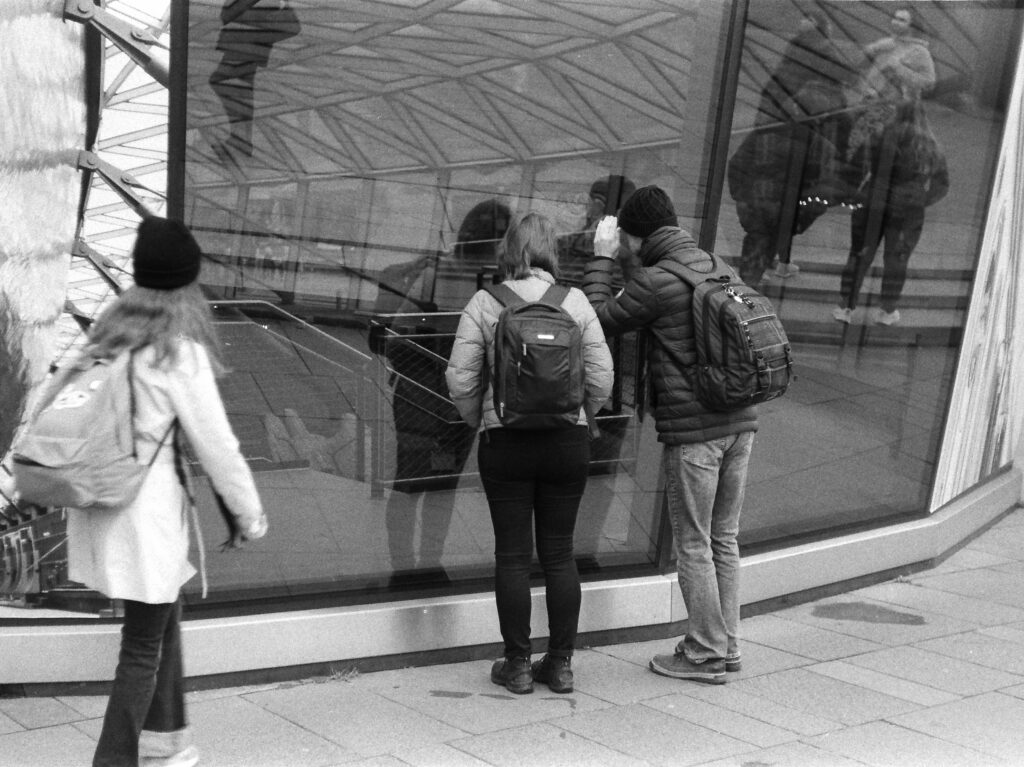





Comments
LE VIET DUNG on Fujica GS645 Professional – A 6×45 Rangefinder Review – By Rob Hawthorn
Comment posted: 22/09/2018
I visited his Instagram, where I found the first photo of this article, "Anna Tatton, Fujifilm Pro 400H", was actually taken from a Olympus camera, not the GS645.
Comment posted: 22/09/2018
Daniel Fjäll on Fujica GS645 Professional – A 6×45 Rangefinder Review – By Rob Hawthorn
Comment posted: 22/09/2018
Comment posted: 22/09/2018
Jacob on Fujica GS645 Professional – A 6×45 Rangefinder Review – By Rob Hawthorn
Comment posted: 22/09/2018
I bought mine with the crappy original bellows and replaced them myself before using it. It is actually a pretty straightforward repair and I would not be put off buying a camera which needs new bellows. The replacement bellows are available on eBay fairly cheaply.
Comment posted: 22/09/2018
Scott Edwards on Fujica GS645 Professional – A 6×45 Rangefinder Review – By Rob Hawthorn
Comment posted: 22/09/2018
Comment posted: 22/09/2018
Devlin Cook on Fujica GS645 Professional – A 6×45 Rangefinder Review – By Rob Hawthorn
Comment posted: 23/09/2018
I recently bought one of these and absolutely love it. The portability and ergonomics make it a real pleasure to use.
One thing that does concern me is the need to cock the shutter before closing the lens door. When it's being stored in this manner, would the shutter not start to fatigue after a long period?
Comment posted: 23/09/2018
Comment posted: 23/09/2018
Terry B on Fujica GS645 Professional – A 6×45 Rangefinder Review – By Rob Hawthorn
Comment posted: 23/09/2018
Owning several folding bellows cameras much older than the Fuji and which still have fully light-tight bellows I was somewhat surprised to read that the GS645, which came out in 1983, seems to have a bellows issue. One of my folders is a pre-war Zeiss 16-on Super Ikonta and so is at least 40 years older, and still has undamaged, although clearly used, bellows.
I do see that the Fuji bellows have quite sharp creases and would appear to be made of a thinner material. Is it leather? I wonder if this is the core problem?
It was interesting to learn about the shoe-mounted close-up rangefinder, especially how this differs in use from the Zeiss Contax Contameters, of which I have all three versions. From your description I can appreciate why Fuji's implementation must be a pain in the backside to use.
Regarding eyesight correction lenses, Fuji do supply them and I got one for my X-Pro 1. They are still available in -1,-2 and -3 dioptres, on their UK website, although the -1 is presently out of stock.
Comment posted: 23/09/2018
Comment posted: 23/09/2018
devlin cook on Fujica GS645 Professional – A 6×45 Rangefinder Review – By Rob Hawthorn
Comment posted: 23/09/2018
Comment posted: 23/09/2018
Rifki Syahputra on Fujica GS645 Professional – A 6×45 Rangefinder Review – By Rob Hawthorn
Comment posted: 24/09/2018
Gaston on Fujica GS645 Professional – A 6×45 Rangefinder Review – By Rob Hawthorn
Comment posted: 12/01/2019
It's been a while so I hope you'll see this. :)
How have you bought your GS645 ? I've been looking to find one fro a while, but I can't find anything but japanese sellers.
I'm a bit afraid I'll have to pay crazy prices for import taxes when purchasing. What's your experience for this ? Cheers !
Comment posted: 12/01/2019
Pablo Aguinaco on Fujica GS645 Professional – A 6×45 Rangefinder Review – By Rob Hawthorn
Comment posted: 06/11/2019
James Evidon on Fujica GS645 Professional – A 6×45 Rangefinder Review – By Rob Hawthorn
Comment posted: 19/11/2019
As a long time Leica user, I find the RF on the Makina is a real pleasure and the images are absolutely stunning. The Bronica ETRS is likewise a stunner, but as an SLR it is quite a handful to manage.The Makina, while heavy, is very compact with the bellows closed up.
I would like to add that but for coming across 35mmc.com I may never have taken up film again, and certainly not medium format. Keep your site going. I visit it daily . It's a keeper.
Comment posted: 19/11/2019
Randall Stewart on Fujica GS645 Professional – A 6×45 Rangefinder Review – By Rob Hawthorn
Comment posted: 26/05/2020
Comment posted: 26/05/2020
Comment posted: 26/05/2020
NO on Fujica GS645 Professional – A 6×45 Rangefinder Review – By Rob Hawthorn
Comment posted: 21/06/2020
I'm looking at potentially getting one of these, but was wondering how yours has held up in 2020?
I'm like of looking for the kind of camera (if I have fine bellows) I won't need to replace or repair for atleast a year or two, just buy and go, so wondering if yours has been fine these last two years?
Can't find anyone else with long term experience, if you still have it!
Thanks,
Comment posted: 21/06/2020
Comment posted: 21/06/2020
Graeme Nicol on Fujica GS645 Professional – A 6×45 Rangefinder Review – By Rob Hawthorn
Comment posted: 04/01/2021
Long on Fujica GS645 Professional – A 6×45 Rangefinder Review – By Rob Hawthorn
Comment posted: 03/11/2021
Joseph on Fujica GS645 Professional – A 6×45 Rangefinder Review – By Rob Hawthorn
Comment posted: 22/02/2022
I came here after seeing a pic of Helmut Newton using one.
Best,
JW, former GA645 shooter
btw, It's "damped". If the aperture ring were "dampened" it would be moist. :-)
Comment posted: 22/02/2022
Mike on Fujica GS645 Professional – A 6×45 Rangefinder Review – By Rob Hawthorn
Comment posted: 12/05/2022
Kalynsky on Fujica GS645 Professional – A 6×45 Rangefinder Review – By Rob Hawthorn
Comment posted: 18/04/2023
Where can I buy a bellows for this camera that is not Chinese?!
I read reviews that the Chinese ones are not ok!
Thanks
John Feole on Fujica GS645 Professional – A 6×45 Rangefinder Review – By Rob Hawthorn
Comment posted: 07/06/2023
Comment posted: 07/06/2023
douglas desmazieres on Fujica GS645 Professional – A 6×45 Rangefinder Review – By Rob Hawthorn
Comment posted: 21/12/2023
do you think It's possible to put an ND filter on the lens??
If yes what size??
Thanks.
beautiful pictures with the fuji btw.